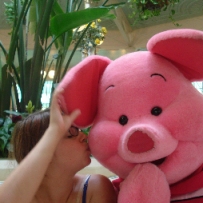I write YA, and I often ask myself, “Does my writing promote good messages to teen girls?”
Now, don’t get me wrong. Stories that preach = BIG FAT NO. Making your story a mouthpiece for your beliefs is never a good idea.
This is not your job.
BUT that doesn’t mean that you’re never allowed to wonder who’s going to read your stories, and what those readers will get out of their experiences.
For my graduate lecture, I took a look at how feminist and post-feminist literary theory can help us look at YA literature and decide for ourselves what messages we want to send. Feminism is, at its core, the belief in equal rights for all genders, but of course there are many definitions and variations among those definitions. The question of choice (who gets to choose, and what they should choose) is sometimes a point of contention among critics.
 I think that one of the reasons so many critics find fault with Twilight and novels like it is because Bella’s choices may be her own, but they are consistently at odds with the choices we want our girls to make. When we show characters who consistently choose dangerous, controlling partners, our fear is that young adult readers will also choose dangerous, controlling partners.
I think that one of the reasons so many critics find fault with Twilight and novels like it is because Bella’s choices may be her own, but they are consistently at odds with the choices we want our girls to make. When we show characters who consistently choose dangerous, controlling partners, our fear is that young adult readers will also choose dangerous, controlling partners.
I don’t think this is an invalid concern, but my intention isn’t to debate or argue it. That’s for another time, another post. My intention is to say, that if you’re a YA writer and this is something you are thinking about, there are ways to develop a good feminist story without making it preachy or propaganda. I’ll share some methods that I found useful and talked about in my lecture.
1. What does your main character want? If it’s just a relationship, consider that in real life, a desire for a relationship is usually a symptom of a deeper desire for something else, like security or acknowledgment. Consider what other forces might be at work, and you’ll avoid creating shallow characters whose problems can be solved by a significant other.
2. Make sure your character stays active. Find places in the story that force her to act, that take away her safety net and test her. This is true of practically any story, but in YA romances, it’s especially important. She doesn’t need to be a hero, but she shouldn’t rely on her love interest too much.
3. Pay attention to your character’s love interest. Speaking of the love interest, don’t forget to pay attention to him! Or her. What does he want? Does he act in a way that harms the main character, and if so, are there negative consequences? If your character has to choose between two love interests (very common these days), is the choice made too easy (by having one character turn out to be a jerk)?
4. Romance novel vs. novel with romantic elements. A romance novel is a little different than a novel with romantic elements. A romance novel’s plot is dependent on the relationship between two characters, so if you want to write a story with feminist undertones, you might choose the other path.
5. Why do your characters get together? Think about the reasons your characters are together. Is it because they find each other so attractive? Or do they share a deep, mutual connection? The more you develop the relationship, and the reasons for it, the more likely you are to connect with readers.
6. The moral of the story. All of these factors combined puts you in a better position to control the final factor: the moral of the story. Once you’ve finished a draft, it might be a good idea to take a look around. What’s happened to the characters? Who’s alive? What have they had to sacrifice? Your character’s rewards and punishments reveal a lot about your story’s message. Is it the message you want?
There are, of course, many more factors than these six that you will need to pay attention to in order to write a great novel. But this is a place to start if your aim is to write a story with romantic elements that will both appeal to teen readers and give them characters and situations they can look up to.
 Rachel Lieberman works in higher education and writes YA. Her short fiction has appeared in Opium, Awkward, Emprise Review, and others. She holds an MFA in Writing for Children and Young Adults from Vermont College of Fine Arts. She lives in Tampa.
Rachel Lieberman works in higher education and writes YA. Her short fiction has appeared in Opium, Awkward, Emprise Review, and others. She holds an MFA in Writing for Children and Young Adults from Vermont College of Fine Arts. She lives in Tampa.
Visit Rachel’s blog: A Reputation in Digital Form: The Writerly Musings of Rachel Lieberman
Follow Rachel on Twitter: @LiebermanRachel
This blog post was brought to you as part of the March Dystropian Madness Blog Series.






